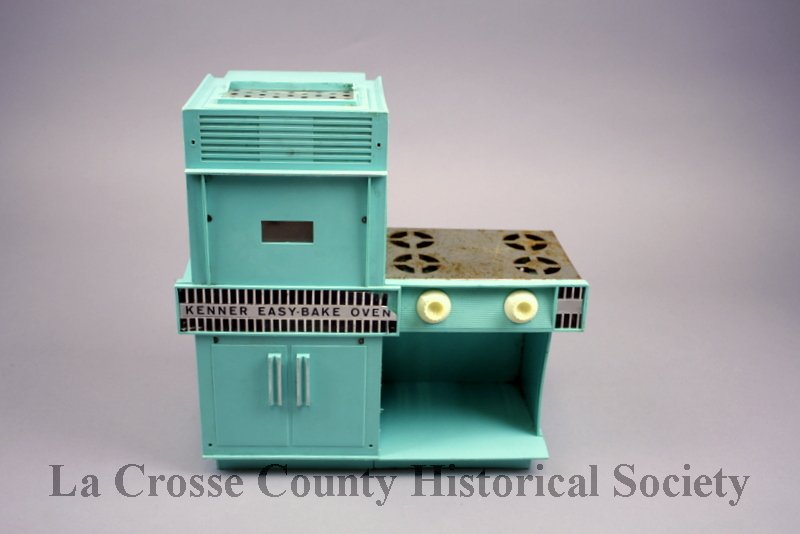Peggy Derrick
Catalog Number: 2014.fic.354
Copyright La Crosse County Historical Society
If I didn’t give it away in the headline, would you recognize what this is? If so, you are either over a certain age, or you know your way around popular-culture icons.
This is the original 1963 Kenner Toy Co. Easy Bake Oven. It baked small cakes with the heat generated by two 100-watt incandescent light bulbs. Children could, as the advertising said, “bake their cake and eat it too.”
What kid could resist that? Apparently not many.
So many adults still have such fond memories of their Easy Bakes that there was great consternation at the first reports that incandescent bulbs were going to be phased out. How would the Easy Bake ever bake again?
When the Easy Bake first came out, it was thought to fill a need for active toys for girls; building sets, chemistry sets and BB guns all were seen as boys’ playthings. It was thought that girls needed interactive toys, too.
Those toys — which included the Easy Bake, the Vac-U-Fun and toy sewing machines — focused on domestic tasks, even though all young children love to help with household chores, not just girls. (An all-too-short childhood phase, in my opinion.)
And, of course, baking and eating cakes, cookies and pies is hardly gender-specific either. Plenty of boys enjoyed Easy Bake Ovens, even if they had to play with a sister’s toy. Some chefs recall their first culinary efforts on Easy Bakes, and in 2003 David Hoffman published a book of chef-authored recipes for the Easy Bake. The “Easy Bake Oven Gourmet” includes recipes for gourmet meals from appetizers through desserts, all in Easy Bake proportions.
The Easy Bake was as popular in La Crosse as in the rest of the country. It did not take long after its 1963 debut for it to become a must-have Christmas gift staple. By 1965, it was found in Christmas ads in the La Crosse Tribune from Kmart, Sears, Jupiter and Bell stores, and the Tractor Supply Co. on Rose Street. In 1966, Tausche’s Hardware also featured it in its ad, as did the new J.C. Penny’s Toyland on Main Street.
Fifty-four years later, after multiple company mergers and design updates, the Easy Bake is still available, made by Hasbro, and looking nothing like this original. The light bulbs have been replaced with a heating unit.
Still marketed almost exclusively to girls, it was available only in pink and purple until one young girl, in 2013, started a social media campaign to get the company to produce a gender-neutral version so her younger brother could enjoy an Easy Bake without being embarrassed or made fun of. The result was a sleek black and silver model.
The Easy Bake’s stature as a classic has been growing for years, as passing generations have grown nostalgic for the toys of their childhood, and references to it on TV shows have raised awareness of its popularity. In 2006 it was inducted into the National Toy Hall of Fame, and in 2011 Time magazine chose it as one of its All Time 100 Best Toys. Clinching its place as a pop-culture icon, Hallmark sold an Easy Bake Keepsake Ornament in 2015.
History and nostalgia intersect in childhood memories, and this Easy Bake, despite its poor condition, is a happy reminder to many of their own past and of times gone by.
This article was originally published in the La Crosse Tribune on December 30, 2017.
This object can be viewed in our online collections database by clicking here.





